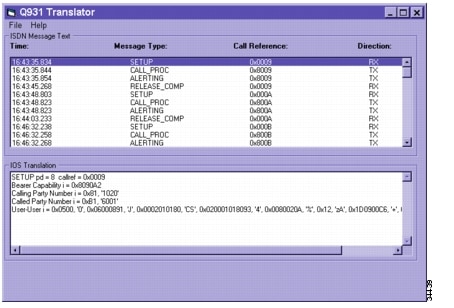

-
Configuring Remote Serviceability for Cisco CallManager, Release 3.0
-
Index
-
About this Guide
-
Introduction to Remote Serviceability
-
Cisco Bridged Telnet
-
The Show Command Interface
-
Using the Performance Console
-
Using the Message Translator
-
Managing with CiscoWorks2000
-
The Path Analysis Interface
-
System Log Management
-
SNMP Instrumentation
-
Cisco Discovery Protocol Support
-
Table Of Contents
Understanding the Translation Process
Using the Message Translator
Cisco CallManager Release 3.0 generates ISDN (Integrated Services Digital Network) trace files, which can be used to diagnose and troubleshoot connectivity problems in your Cisco CallManager installations. The logs containing this information contain Q.931 type messages (ISDN Layer 3 protocol).
Using the Message Translator tool, Cisco Support Engineers can easily translate your incoming debugging information into more familiar Cisco IOS-equivalent messages simply by selecting a line of a log file.
Understanding the Translation Process
The Message Translator works by filtering incoming data from Cisco CallManager SDI log files, then parsing and translating them into Cisco IOS-equivalent messages. The application displays the messages in the Message Translator interface, as shown in Figure 5-1.
Using the Message Translator
Start the message translation process by using the following procedure to locate the SDI log file in the directory structure.
Figure 5-1 Sample Message Translation
Step 1
First pull down the File menu and select Open.
Step 2
Select a log file in the directory listing for translation to Cisco IOS.
Step 3
To save the log file you have selected from the directory listing, type in a name that will identify it as a translated Cisco IOS log file.
Step 4
Note that the log file you select is loaded into the top box of the Message Translator. (See Figure 5-1).
Step 5
Select the message to be translated.
Step 6
Note that the Cisco IOS translation of the selected message appears immediately in the ISDN translation box at the bottom of the screen.
Step 7
Keeping the translated files on hand may be of use to you later on. To do this, pull down the File menu and select the Save As IOS option, which translates and saves all ISDN messages in the logfile.

 Feedback
Feedback